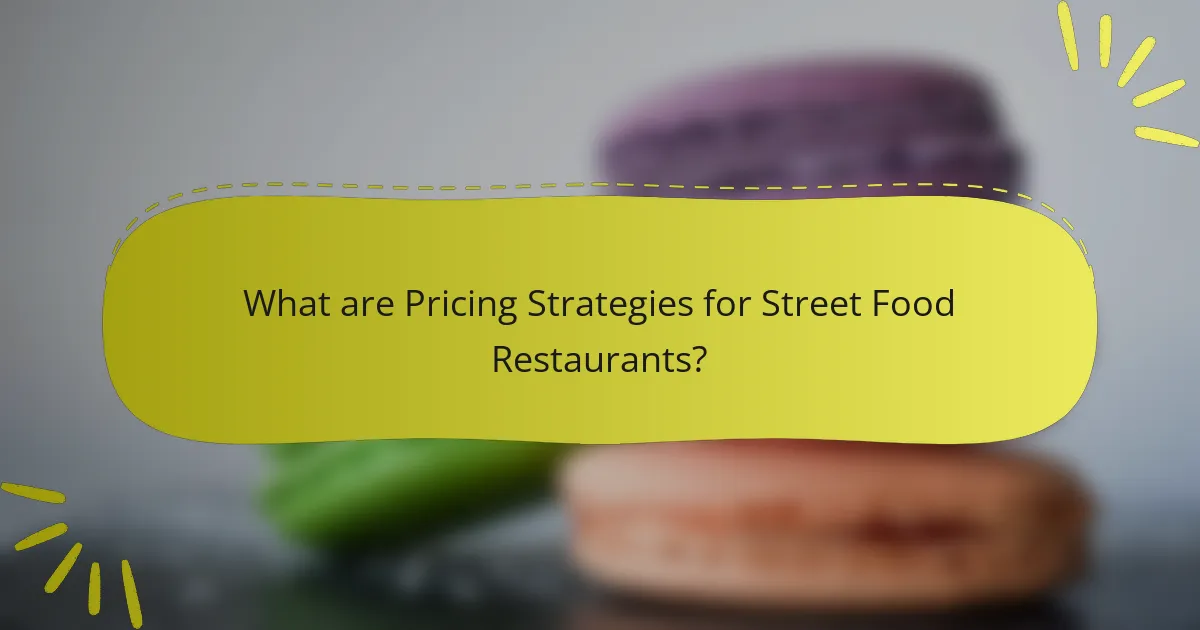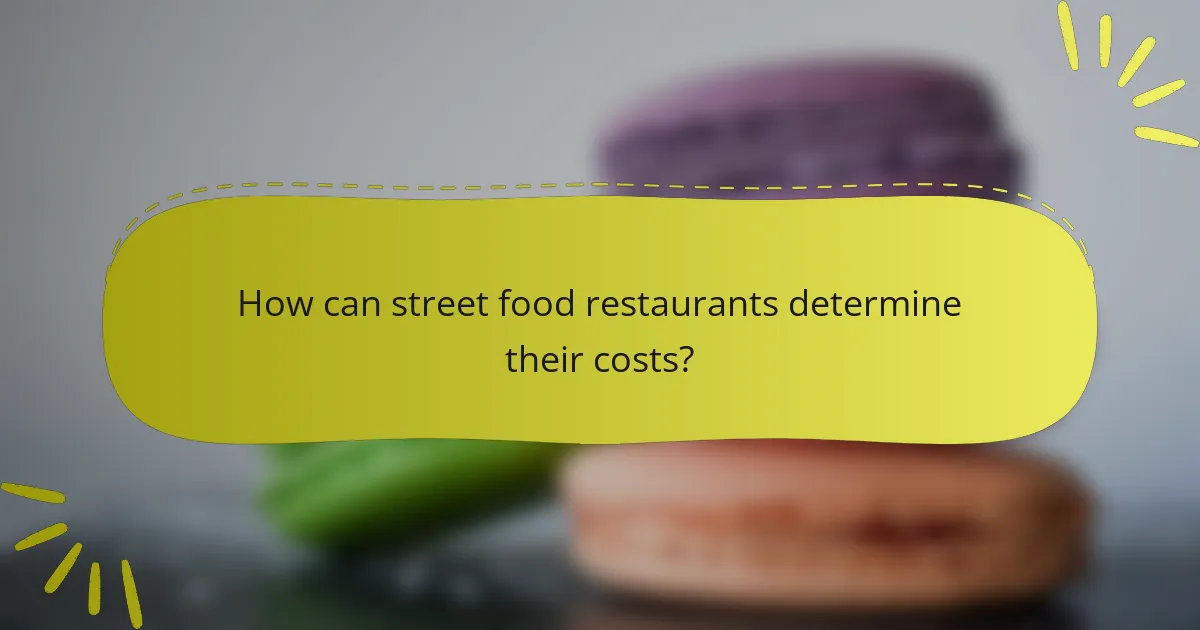Pricing strategies for street food restaurants are essential for attracting customers and maximizing profits. Key strategies include cost-plus pricing, where a markup is added to ingredient costs, and competitive pricing, which aligns prices with nearby vendors. Value-based pricing considers perceived customer value, while dynamic pricing adjusts for demand fluctuations. Psychological pricing techniques, such as pricing items just below whole numbers, can influence customer perceptions. Additionally, understanding operational costs, conducting market research, and analyzing customer feedback are crucial for setting competitive and sustainable prices in the street food industry.

What are Pricing Strategies for Street Food Restaurants?
Street food restaurants typically employ various pricing strategies to attract customers and maximize profits. Common strategies include cost-plus pricing, where prices are set by adding a markup to the cost of ingredients. Competitive pricing is also prevalent, where prices are aligned with nearby vendors to remain attractive. Value-based pricing focuses on perceived customer value, allowing restaurants to charge more for unique offerings. Dynamic pricing adjusts prices based on demand fluctuations, especially during peak hours or events. Psychological pricing, such as pricing items at $4.99 instead of $5.00, can also influence customer perceptions. These strategies help street food restaurants navigate market competition and consumer behavior effectively.
How do pricing strategies impact street food restaurant success?
Pricing strategies significantly impact street food restaurant success. They determine customer perception and influence purchasing decisions. Competitive pricing can attract more customers, increasing sales volume. Conversely, premium pricing can create a perception of higher quality. Research indicates that price sensitivity varies among different customer segments. For instance, budget-conscious consumers may be deterred by high prices. A well-researched pricing strategy aligns menu offerings with target demographics. According to a study by the Journal of Foodservice Business Research, effective pricing strategies can enhance profitability by up to 20%. Thus, strategic pricing is crucial for sustaining street food restaurant success.
What are the key elements of effective pricing strategies?
Effective pricing strategies encompass several key elements. These include understanding costs, market demand, and customer perception. Knowing fixed and variable costs allows for proper pricing that ensures profitability. Analyzing market demand helps in setting competitive prices. Customer perception influences how prices are viewed in relation to value. Additionally, pricing strategies should be flexible to adapt to market changes. Regularly reviewing and adjusting prices based on sales data is crucial. Implementing psychological pricing techniques can also enhance customer appeal. These elements collectively contribute to a successful pricing strategy in street food restaurants.
How do pricing strategies influence customer choices?
Pricing strategies significantly influence customer choices by shaping perceived value and affordability. Different pricing approaches, such as premium, competitive, or discount pricing, impact how customers view a product. For instance, premium pricing can create a perception of higher quality. Conversely, competitive pricing may attract cost-conscious consumers.
Research indicates that 70% of consumers consider price as a key factor in their purchasing decisions. Additionally, psychological pricing, such as setting prices just below whole numbers, can enhance attractiveness. Customers often associate lower prices with better deals, influencing their choice to purchase.
In street food restaurants, strategic pricing can attract diverse customer segments. Offering value meals can appeal to budget-conscious individuals. Meanwhile, unique or gourmet items can justify higher prices, targeting customers seeking quality experiences. Thus, effective pricing strategies are essential for influencing customer preferences and driving sales.
What factors should be considered in pricing street food?
Factors to consider in pricing street food include ingredient costs, labor expenses, and overhead costs. Ingredient costs directly affect the base price of each dish. Labor expenses include wages for staff preparing and selling the food. Overhead costs encompass permits, equipment, and utilities.
Additionally, market demand influences pricing strategies. High demand can justify higher prices. Competition in the area also affects pricing; lower prices may be necessary to attract customers. Seasonal availability of ingredients can alter costs and pricing.
Lastly, customer perception plays a role in pricing. Quality and uniqueness of the food can allow for premium pricing. Research indicates that well-priced street food can significantly impact sales and profitability.
How do ingredient costs affect menu pricing?
Ingredient costs directly influence menu pricing by determining the base expenses of each dish. Higher ingredient costs lead to increased menu prices to maintain profit margins. Conversely, lower ingredient costs can allow for competitive pricing or higher profit margins. For instance, if the cost of key ingredients rises by 20%, restaurants may need to increase menu prices correspondingly to cover these expenses. This relationship ensures that restaurants remain financially viable while also reflecting market conditions. Additionally, fluctuations in ingredient availability can lead to price adjustments, impacting overall pricing strategies.
What role does location play in pricing strategies?
Location significantly influences pricing strategies for street food restaurants. Different locations have varying levels of demand, competition, and customer demographics. For instance, urban areas typically have higher prices due to increased foot traffic and higher rent costs. Conversely, rural areas may require lower prices to attract customers.
Additionally, the local cost of ingredients can vary by region, affecting menu prices. A study by the National Restaurant Association highlights that 70% of consumers consider location when deciding where to eat, indicating its critical role in pricing. Furthermore, street food vendors often adjust prices based on local economic conditions and consumer purchasing power. This adaptability ensures competitiveness and profitability.

How can street food restaurants determine their costs?
Street food restaurants can determine their costs by calculating all expenses associated with their operations. This includes ingredient costs, labor expenses, and overhead costs such as permits and equipment.
They should track the quantity and price of ingredients used in each dish. Labor costs should factor in wages, benefits, and hours worked. Overhead costs include rent, utilities, and insurance.
Using a cost-plus pricing strategy can help ensure profitability. This involves adding a markup to the total cost to set menu prices. Regularly reviewing these costs is essential for maintaining accurate pricing.
Market research can also inform pricing strategies by analyzing competitors’ prices. This comprehensive approach allows street food restaurants to set competitive and sustainable prices.
What are the main cost components for street food businesses?
The main cost components for street food businesses include food ingredients, equipment, permits, and labor. Food ingredients account for a significant portion of expenses, often ranging from 25% to 35% of total costs. Equipment costs can vary widely but typically include cooking appliances, serving utensils, and storage solutions. Permits and licenses are necessary for legal operation and can incur fees that differ by location. Labor costs, including wages for staff, also contribute substantially to overall expenses. Additionally, marketing and transportation costs may impact profitability. Understanding these components is crucial for effective pricing strategies.
How do fixed and variable costs differ in street food operations?
Fixed costs in street food operations remain constant regardless of sales volume. Examples include permits, equipment, and rental fees. Variable costs fluctuate with sales levels. These include ingredients, packaging, and labor costs. For instance, purchasing more ingredients increases variable costs with higher sales. Understanding these differences helps in pricing strategies. Properly managing fixed and variable costs can enhance profitability.
What are some common hidden costs in street food management?
Common hidden costs in street food management include equipment maintenance, licensing fees, and ingredient spoilage. Equipment maintenance can lead to unexpected expenses. Regular upkeep is essential to avoid breakdowns. Licensing fees may vary by location and can be overlooked in initial budgeting. Ingredient spoilage occurs due to improper storage or over-purchasing. Additionally, labor costs often include overtime or training expenses that are not initially accounted for. Marketing and promotional costs can also add up, especially if relying on social media and local advertising. Lastly, insurance costs can be higher than anticipated, particularly for liability coverage. These factors collectively impact the overall profitability of street food operations.
Why is understanding customer perception important for pricing?
Understanding customer perception is crucial for pricing because it directly influences purchasing decisions. Price perception affects how customers view value and quality. If customers perceive a price as too high, they may associate it with poor value. Conversely, a lower price might lead to assumptions of lower quality. Research shows that 70% of consumers base their buying decisions on perceived value. Accurate pricing aligned with customer perception can enhance sales and customer loyalty. Businesses that understand this dynamic can better position their products in the market.
How does customer perception influence pricing strategies?
Customer perception significantly influences pricing strategies by affecting how consumers value products. When customers perceive a product as high quality, they are willing to pay a premium price. Conversely, if a product is viewed as low quality, customers expect lower prices. Research indicates that perceived value can account for up to 40% of consumer purchasing decisions.
Additionally, brand reputation plays a crucial role. A strong brand can command higher prices due to positive customer associations. In street food restaurants, unique offerings or local ingredients can enhance perceived value. This perception allows restaurants to implement higher pricing strategies successfully.
Moreover, customer feedback shapes pricing adjustments. If customers express dissatisfaction with prices, restaurants may need to reconsider their pricing strategies. Overall, aligning pricing with customer perception is essential for maximizing profitability.
What methods can be used to gauge customer perception?
Surveys and questionnaires are effective methods to gauge customer perception. These tools collect direct feedback from customers about their experiences and opinions. Focus groups allow for in-depth discussions among selected customers. This method uncovers deeper insights into customer feelings and attitudes. Social media monitoring tracks customer sentiments expressed online. Analyzing reviews and ratings provides quantitative data on customer satisfaction. Observational research involves studying customer behavior in real-time at the restaurant. This method reveals how customers interact with the menu and pricing. Each of these methods contributes to a comprehensive understanding of customer perception in the context of street food pricing strategies.

What are effective menu pricing techniques for street food restaurants?
Effective menu pricing techniques for street food restaurants include cost-plus pricing and psychological pricing. Cost-plus pricing involves calculating total food costs and adding a markup for profit. This ensures expenses are covered while generating revenue. Psychological pricing leverages pricing strategies that appeal to customer perceptions. For instance, pricing items at $4.99 instead of $5.00 can make a dish seem more affordable.
Additionally, offering bundle deals can encourage higher sales volumes. For example, a combo meal priced lower than individual items increases perceived value. Market research is crucial for understanding competitors’ pricing. This helps in setting competitive prices without undervaluing offerings.
Analyzing customer feedback can also guide pricing adjustments. It ensures the menu aligns with customer willingness to pay. Lastly, seasonal pricing can maximize profits during peak times by adjusting prices based on demand.
How can value-based pricing be applied in street food?
Value-based pricing can be applied in street food by aligning prices with the perceived value to customers. Street food vendors can assess customer preferences and willingness to pay for unique flavors or experiences. For instance, a vendor offering organic ingredients can charge more based on the health benefits perceived by customers. Additionally, vendors can gather feedback to refine their offerings and adjust prices accordingly. Research shows that consumers are willing to pay higher prices for quality and authenticity in street food. This approach ensures that pricing reflects the value delivered, enhancing customer satisfaction and loyalty.
What are the benefits of value-based pricing for street food vendors?
Value-based pricing benefits street food vendors by aligning prices with customer perceptions of value. This strategy allows vendors to charge more for unique offerings. It can increase profit margins significantly. Customers are often willing to pay a premium for perceived quality. This approach encourages vendors to enhance product quality and service. It fosters customer loyalty by meeting and exceeding expectations. Additionally, value-based pricing can differentiate vendors from competitors. This can lead to increased market share in a crowded street food landscape.
How does perceived value affect customer willingness to pay?
Perceived value significantly influences customer willingness to pay. When customers believe a product or service offers high value, they are more inclined to pay a premium price. This relationship is evident in various market studies. For example, a study by Monroe (1990) found that perceived quality directly correlates with price acceptance. Customers often assess value based on quality, brand reputation, and personal experiences. Higher perceived value can lead to increased customer loyalty and repeat purchases. Thus, understanding and enhancing perceived value is crucial for pricing strategies in street food restaurants.
What pricing models work best for street food restaurants?
Dynamic pricing, value-based pricing, and cost-plus pricing work best for street food restaurants. Dynamic pricing adjusts prices based on demand fluctuations. This model maximizes revenue during peak times. Value-based pricing sets prices based on perceived customer value. It can enhance customer satisfaction and loyalty. Cost-plus pricing ensures all costs are covered while providing a profit margin. This model is straightforward and easy to implement. Research indicates that street food vendors often benefit from flexible pricing strategies to adapt to market conditions.
How does dynamic pricing adapt to market changes?
Dynamic pricing adapts to market changes by adjusting prices based on real-time supply and demand conditions. This strategy allows businesses to respond quickly to fluctuations in consumer behavior and market trends. For instance, during peak hours, prices may increase to maximize revenue from high demand. Conversely, during off-peak times, prices may decrease to attract more customers. Data analytics plays a crucial role in this process, enabling businesses to monitor market conditions effectively. Research indicates that companies using dynamic pricing can increase their revenue by up to 25%. This adaptability ensures that prices remain competitive and aligned with market expectations.
What are the advantages of psychological pricing in street food?
Psychological pricing in street food offers several advantages. It helps attract customers by presenting prices that appear lower than they actually are. For example, pricing an item at $4.99 instead of $5.00 can increase sales. This strategy leverages consumer perception, making products seem more affordable. It can also create a sense of urgency or exclusivity, encouraging quicker purchasing decisions.
Additionally, psychological pricing can enhance customer satisfaction. When customers perceive they are getting a better deal, they are more likely to return. Research indicates that consumers often make decisions based on emotional responses rather than rational evaluations.
Therefore, implementing psychological pricing can lead to increased foot traffic and repeat business in street food settings.
What practical tips can street food restaurants use to optimize pricing?
Street food restaurants can optimize pricing by analyzing food costs and adjusting menu prices accordingly. They should calculate the cost of ingredients, labor, and overhead to establish a baseline. Setting prices at a minimum of 30% above food costs is a common practice. Offering combo deals can increase perceived value and encourage larger purchases. Regularly reviewing competitor pricing helps ensure competitiveness in the market. Implementing dynamic pricing based on demand during peak hours can maximize revenue. Customer feedback on pricing can guide adjustments to meet expectations. Finally, utilizing psychological pricing, such as pricing items at $4.99 instead of $5.00, can influence buying behavior positively.
How can street food vendors test different pricing strategies effectively?
Street food vendors can test different pricing strategies effectively by implementing A/B testing. This involves offering two price points for the same item to different customer groups. Vendors can track sales data to identify which price generates higher revenue. Additionally, they can gather customer feedback through surveys to understand perceptions of value. Analyzing the results allows vendors to adjust pricing based on customer preferences. Research indicates that small price changes can significantly impact sales volume. For example, a study by the Journal of Marketing found that a 10% price decrease can lead to a 20% increase in sales for food items.
What common mistakes should be avoided in pricing decisions?
Common mistakes to avoid in pricing decisions include underpricing products, failing to consider costs, and neglecting customer perception. Underpricing can lead to reduced profit margins and financial instability. Ignoring costs may result in unsustainable pricing strategies. Additionally, not aligning prices with customer expectations can alienate potential buyers. Research indicates that 60% of small businesses struggle with pricing due to these factors. Therefore, it’s crucial to conduct thorough market analysis and cost assessments to inform pricing strategies effectively.
Pricing strategies for street food restaurants focus on various methods to attract customers and maximize profits. Key strategies include cost-plus pricing, competitive pricing, value-based pricing, dynamic pricing, and psychological pricing, each influencing customer perception and purchasing decisions. The article explores how these strategies impact restaurant success by aligning menu offerings with customer demographics, understanding costs, and adapting to market demand. It also emphasizes the importance of gauging customer perception and adjusting pricing accordingly to enhance profitability and maintain competitiveness in the street food market.